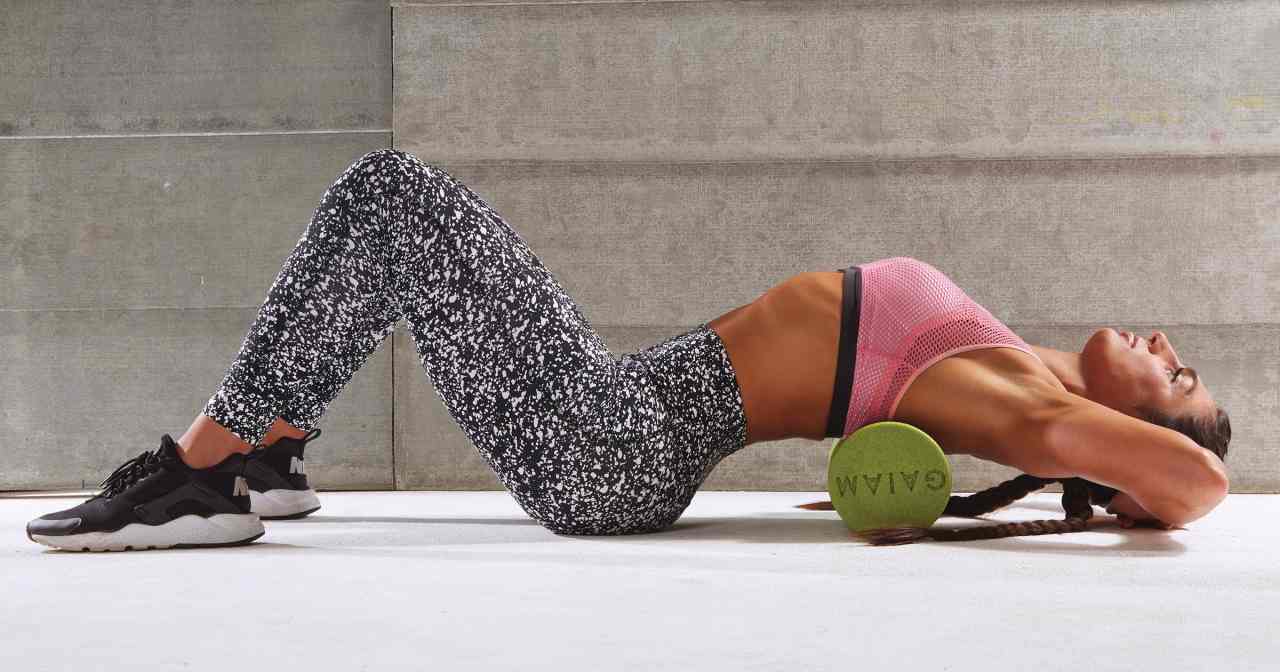
Sustaining spinal integrity throughout train is paramount, however preserving your backbone protected goes past the easy directive of sustaining good posture when performing huge or heavy actions. It additionally expands into programming, exercise timing and extra. Right here’s learn how to hold your backbone protected and wholesome from high to backside and enhance your ends in the method.
Cervical Backbone
With out your cervical backbone, you’d lose your head — actually. This space consists of seven vertebrae originating on the backside of your cranium and operating down your neck to shoulder/clavicle top. It really works to help your head, transfer your backbone and shield your spinal twine.
A typical instruction when lifting is to keep up a impartial backbone, however lots of people neglect to incorporate the cervical backbone in that directive. It doesn’t matter what compound motion you’re performing, your head ought to comply with your torso each step of the way in which. It’s best to by no means be trying up (hyperextending) or trying down (rounding over), which might trigger compression within the cervical disks. And since the neck muscle tissue that stabilize this space are a lot smaller and fewer highly effective than the large spinal erectors that help the lumbar and thoracic backbone, they’re extra simply injured.
Apart from executing correct type 24/7, strengthening the muscle tissue that help the cervical backbone 360 levels round will assist you to keep correct head posture throughout your exercise and in all of your life actions.
Do these two workout routines preworkout to prep for the larger compound actions to return.
Neck Elevate
Do three to 4 units of 30-second holds.
Lie faceup together with your arms bent 90 levels on both facet of your head, palms dealing with up. Actively press your arms and palms down into the ground as you elevate your head and neck up so far as you’ll be able to with out tucking your chin. Decrease to the beginning and relaxation briefly, then repeat.
Chin Tuck
Do six units of 10-second holds.
Stand together with your again to a wall so your shoulders and glutes are touching and your heels are towards the baseboard. Gently tuck your chin into your neck, and push the again of your head into the wall, step by step growing the power as should you had been attempting to depart an impression. Launch, relaxation briefly, then repeat.
Thoracic Backbone
The thoracic backbone consists of the 12 vertebrae situated in your higher and center again, originating on the finish of the cervical backbone and lengthening about 5 inches past the shoulder blades to the highest of the lumbar backbone. Your ribs are hooked up on both facet to every thoracic vertebra, and people hooked up to T1 by T10 are additionally anchored within the entrance on the sternum.
As a result of this part of your backbone is designed to guard and home your coronary heart and lungs, it’s pretty inflexible and has restricted mobility. What motion it does have is used for rotation. Nonetheless, most individuals should not have excellent mobility on this space, and this lack of rotational capability is often compensated for by the lumbar area. Since your thoracic backbone ought to have about 5 instances the rotational capability of your lumbar backbone, that is problematic. Strengthening and mobilizing this space is crucial to guard your decrease again whereas bettering efficiency.
Use these strikes to mobilize your thoracic backbone preworkout.
Foam-Curler Extension
Do 4 reps of 30-second holds.
Lie faceup and place a foam curler beneath you throughout your shoulder blades. Maintain your glutes involved with the ground as you calm down utterly over the curler, respiratory deeply. With every breath, attempt to calm down somewhat extra and deepen the stretch.
Kettlebell Passive Rotation
Do 4 units of 10 (both sides).
Lie faceup and maintain a light-weight drugs ball between your knees. Raise your knees over your hips, legs bent 90 levels. Maintain a kettlebell in a single hand over your shoulder and lengthen your different arm straight out to the facet, palm down. Press each shoulders into the ground and hold your raised arm straight as you slowly decrease your knees away from the loaded arm towards the ground. Gently contact them to the bottom, then return to the beginning. Do all reps on one facet, then swap.
Lumbar Backbone
Your lumbar backbone consists of 5, thick vertebrae, and its perform is to help the load of your torso and head — a tall order for simply 5 hyperlinks within the chain. Now add to that the already burdensome job an overhead load comparable to with a squat or shoulder press and also you’ll perceive why the decrease again is probably the most usually injured space of the backbone.
The lumbar backbone can rotate, flex and lengthen, however despite the fact that it’s fairly cell, utilizing right train type is important. You in all probability already know that when organising for a squat or deadlift, a rounded again is sort of harmful. Nonetheless, overcompensating by arching your again is not any higher and may trigger vertebral compression, tilting the pelvis ahead fairly aggressively and shutting down the glutes and decrease abs.
This transfer trains your decrease again to withstand extreme arching. Do it preworkout to get up your core muscle tissue in preparation for lifting.
Decrease-back ache is the main explanation for incapacity worldwide, in keeping with The International Burden of Illness.
Sensible Functions
Designing your exercises to help spinal well being is crucial if you wish to stay erect into your 90s (and past). Listed here are some elements to think about when planning your programming.
Superset Smarts
Supersets are a superb approach for reinforcing depth and quantity, pairing two strikes back-to-back that concentrate on the identical muscle group. Nonetheless, should you’re lifting heavy, your backbone endures numerous compression, so one of the best ways to do a superset is by pairing a transfer that has a heavy spinal load with a transfer that has a light-weight spinal load. This lets you keep correct type and nonetheless get nice outcomes.
Carry out 4 units of 10 reps apiece of every transfer in your superset. For a loaded carry, shoot for 45 to 60 seconds for every of 4 rounds.
Pattern Superset Pairings
| Excessive Compression | Low Compression |
| Squat | Hanging Leg Elevate |
| Deadlift | Chin-Up |
| Overhead Press | Lat Pulldown |
| Loaded Carry | Dip |
| Bent-Over Row | Bench Press |
Prolonged Plank Stroll
Do 4 units of six to eight reps.
Stand together with your ft hip-width aside, arms at your sides. Fold ahead and plant your palms on the ground in entrance of you. Preserve a impartial backbone as you stroll your palms away out of your ft till you come into plank (palms beneath your shoulders and your head, hips and heels aligned), then stroll your palms out two to 4 extra steps so that you’re in an prolonged plank. Maintain for 3 seconds, preserving your core tight and squeezing your glutes so your hips keep in place, then stroll your palms all the way in which again to your ft. Both arise and regroup or simply go proper into the subsequent rep.
Isometric Half-Kneeling Rotation
Do 5 units of 15 seconds (per facet).
Assume a half-kneeling place together with your left leg ahead subsequent to an immovable object comparable to a pole, doorway or squat rack. Lengthen your arms in entrance of you at shoulder top and hyperlink your palms, positioning them on the proper facet of the pole. Apply strain into the beam with straight arms by partaking all of the muscle tissue that will trigger you to rotate to the left with out truly transferring. Think about you wish to push proper by the pole. Launch, relaxation briefly, then repeat.
With isometric coaching, there may be little to no precise motion.
Isometric Deadlift Pull
Do six units of 10 to fifteen seconds.
Load a barbell with 50 p.c extra weight than you’ll be able to elevate in your one-rep max so there isn’t any means you’ll be able to transfer it. Stand together with your toes below the bar and grasp it exterior your legs in both an overhand or an alternating grip, shoulders over the bar. Your knees needs to be barely bent, hips greater than your knees, head aligned together with your backbone. As should you had been going to do a deadlift, contract all of your muscle tissue and pull upward as arduous as you’ll be able to for a full 10 to fifteen seconds. Launch, relaxation briefly, then repeat.
Time Your Coaching
You may need heard folks say that they’re taller within the morning and shorter at night time, and there may be truly some reality to this: Mendacity horizontally for eight hours permits the backbone to decompress, and because it relaxes, extra intervertebral fluid enters the disks, making it stiff upon waking. This fluid wants time to empty off earlier than you train since you are at higher danger for disk impingement and even herniation when your spinal column is inflexible.
Because of this, doing heavy squats and deadlifts at 6 a.m. could also be doing all of your backbone extra hurt than good. These vertical pushing actions place a direct load on the vertebrae and are often the lifts folks strive for the heaviest weights. If doable, stand up two hours earlier than you’re employed out. Can’t make that occur? Both deal with lower-compression actions or put your huge lifts to return final on the menu, focusing extra on type and reps than on weight.
Transfer Ahead by Not Transferring
Isometric coaching — creating power towards an immovable object — generally is a huge assist in the hunt for spinal well being, with little or no danger for harm. Asking your trunk muscle tissue to withstand undesirable forces by merely holding type is a wiser coaching directive than asking them to create power and make the backbone transfer — for instance, a plank or a facet plank versus a twisting ab crunch.
Coaching your physique to be stronger in probably the most troublesome a part of a elevate is an effective use for isometrics. Take a deadlift, for instance: The bar begins on the ground, and since gravity is doing its finest to maintain that bar grounded, getting it to maneuver upward is probably the most troublesome level of the elevate. As soon as in movement, kinetic power helps generate momentum throughout the remainder of the motion. So isometric work helps construct energy and muscle recruitment the place you really need it most.
You should use isometrics as a part of your motion prep or as their very own exercise completely. In any case, do strikes like these two when your muscle tissue are contemporary and able to produce maximal power in a protected setting.











